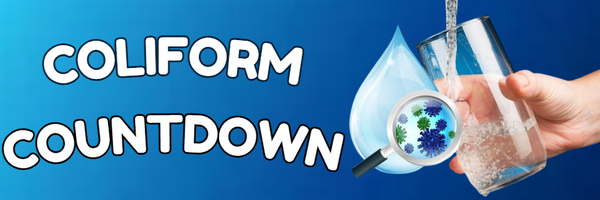Coliform Countdown, a Deep Dive into Clean Water Purification
Grade 5
Presentation
Hypothesis
Main Objective
The presence of bacterial pathogens, especially coliforms, in water poses significant risks to human health. Understanding which purification method is most effective in eliminating these pathogens is crucial for ensuring the safety of drinking water.
Question
Over-Arching Question: Which water purification method is most effective in reducing bacterial pathogens, particularly coliforms, in contaminated water?
Main Problem: The presence of bacterial pathogens, especially coliforms, in water poses significant risks to human health. Understanding which purification method is most effective in eliminating these pathogens is crucial for ensuring the safety of drinking water.
Hypothesis
If I test different water purification methods to remove bacterial pathogens then, boiling will have the largest reduction in coliforms compared to the original sample because, the heat damages the bacteria’s structural components and stops essential life processes.
Research
Abstract
Water contamination is a significant global concern, driven by various pollutants such as industrial discharge, agricultural runoff, municipal waste, and airborne contaminants. These pollutants introduce harmful substances into water bodies, which can have serious consequences on both human health and ecosystems. Common contaminants found in natural water sources include chemicals, sediments, pesticides, animal waste, and biological pathogens, all of which pose a risk to both environmental and public health. The effects of water pollution are far-reaching, resulting in diseases, ecosystem degradation, loss of biodiversity, and the collapse of aquatic environments. Filtration methods, including activated carbon filters, reverse osmosis systems, ultraviolet purifiers, mechanical filters, and distillation units, play a crucial role in improving water quality in households. While each method offers specific benefits, they also have limitations, such as the inability to remove certain contaminants or the requirement for professional installation. Understanding the causes, impacts, and filtration solutions for water contamination is essential for mitigating its effects and ensuring access to clean, safe water.
Background Research Questions
What Causes Water Contamination/Pollution?
Water is known as a “universal solvent” because it can dissolve more substances than any other liquid on Earth, making it very crucial for life but also highly susceptible to pollution. Pollution enters water bodies through various pathways, including industrial discharge from factories, agricultural runoff containing fertilizers, pesticides, and animal waste, municipal discharge such as wastewater and sewage, runoff and spills of chemicals, and the deposition of airborne pollutants. These sources introduce many toxic synthetic chemicals that cannot be broken down by natural processes and can cause significant harm even in small amounts. Unwanted impurities in water also arise from contact with industrial sewage and wastewater, agricultural waste, decomposing organic matter in water bodies, and chemical imbalances that promote microbial growth. Together, these factors make water pollution a complex and pressing environmental issue.
Main Causes:
- Industrial discharge
- Agriculture run-off
- Municipial waste
- Chemical spills/ run- offs
- Decomposing organic matter
- Airborne pollutants

Figure 2.1.1: Common lakewater waste bioproducts, causing internal and external damage.
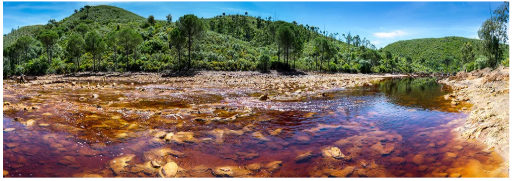
Figure 2.1.2: Agriculture run-off in lake water.
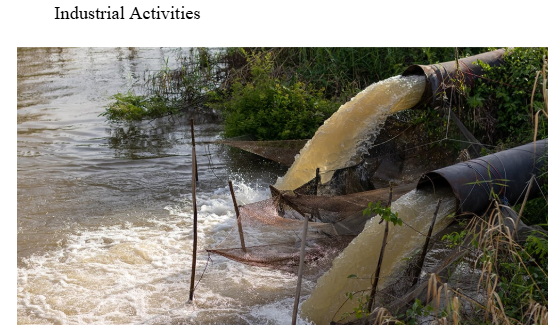
Figure 2.1.3: Factories dumping out waste water/ toxic water with chemicals in it to lakes.
What are the most common contaminants found in natural water sources like lakes?
Sediment, chemicals, animal waste, fertilizers, and pesticides can end up in all types of water bodies, including lakes, ponds, and groundwater, when not properly managed. Water from rainfall, streams, and wells often picks up harmful substances like acids and metallic elements from the environment, further contaminating these water sources. Biological components such as bacteria, algae, organic waste, amino acids, pathogens, viruses, microbes, and parasites also contribute to water pollution, posing significant risks to both ecosystems and human health. Impurities in water include dust, dirt, harmful chemicals, biological contaminants, radiological contaminants, and total suspended solids (TSS), which are visible particles that make water appear cloudy or hazy. Pollution processes like eutrophication, caused by excess nutrients from fertilizers, lead to algal blooms and oxygen depletion, while acidification from pollutants like acid rain increases water acidity. Toxic contamination from synthetic chemicals and heavy metals, along with sediment accumulation and runoff from agricultural or industrial activities, further degrade water quality, making it a critical environmental issue.
What are the impacts of water contamination? How do these contaminants affect human health and ecosystems?
Impact on Human Health: Disease & Illness
Water pollution has devastating effects on human health, causing both small and fatal conditions. In 2015, it was responsible for 1.8 million deaths, according to a study published in The Lancet. Each year, around 1 billion people become ill from unsafe water, with low-income communities being disproportionately affected as they often live near heavily polluting industries. Contaminated drinking water containing unsafe levels of pathogens, chemicals, or heavy metals can lead to gastrointestinal illnesses, reproductive and nervous system issues, developmental abnormalities, and chronic diseases such as cancer. Waterborne pathogens, including bacteria and viruses from human and animal waste, are a major cause of diseases such as cholera, giardia, typhoid, and hepatitis. Illnesses caused by viruses, bacteria, and parasites can result in stomach pain, vomiting, diarrhea, fever, and even kidney failure. Swimming in polluted water or consuming fish and seafood from contaminated sources also poses significant health risks.
Disruptions in the Food Web and Destruction of Ecosystems
Water pollution severely disrupts the food web and destroys ecosystems, causing long-lasting harm to biodiversity and the balance of aquatic environments. Primary producers, such as algae and aquatic plants, form the foundation of the food chain by converting sunlight into energy for herbivores. When pollutants hinder their growth or kill them, herbivores experience a population decline, which directly impacts carnivores and other predators that rely on them for sustenance. Toxic substances, such as pesticides and heavy metals, accumulate in aquatic organisms, and as larger predators consume these contaminated species, the toxins become more concentrated, threatening their health and survival. Pollutants also disrupt the natural habitats of many aquatic species, leading to habitat degradation and even extinction of vulnerable populations. Changes in water quality, toxic contamination, and the loss of key species significantly disturb the delicate balance of ecosystems, leaving long-term apnd often irreversible effects on aquatic life and the environment as a whole.
Decline in Biodiversity and Ecosystem Collapse
One of the most noticeable impacts of water contamination is the decline in biodiversity. Pollutants disrupt the natural habitats of countless aquatic species, often driving some to extinction. Beyond habitat destruction, chemicals and toxins in polluted water alter critical factors such as pH levels, oxygen content, and temperature, creating harsh conditions that make survival nearly impossible for aquatic organisms. These changes throw ecosystems out of balance, as the loss of one species can set off a chain reaction, disrupting food webs and ecosystem dynamics. Such disruptions can escalate in a catastrophic way, ultimately leading to the collapse of entire environments and the loss of invaluable biodiversity.
Which filtration methods are most commonly used in households, and why?
Activated Carbon Filters
Activated carbon filters are highly effective at removing chlorine and other chemicals that cause unpleasant tastes and odors, significantly enhancing water quality. They are affordable and come in various forms like pitcher filters and faucet attachments. However, they are limited in removing inorganic pollutants, heavy metals, and microorganisms. Regular replacement of filter cartridges is essential to maintain effectiveness and prevent bacterial growth. I chose this technique was cost effective and very accesible and easy to use, which followed my guidelines to my experiment.
Reverse Osmosis (RO) Systems
RO systems provide comprehensive filtration, removing contaminants such as heavy metals, nitrates, fluoride, and other impurities, delivering purified water with improved taste and odor. Despite their effectiveness, they produce significant wastewater during the filtration process, making them less eco-friendly. These systems require a higher initial investment, professional installation, and regular maintenance, including replacing membranes, to ensure consistent performance. I decided not to manipulate this methos becuse it did not fit my guidelines. This techinque was very expensive as you had to install varouis pipes to make use of the RO system.

Figure 2.4.1: How reverse osmosis works and how it removes polluntantants.
Ultraviolet (UV) Purifiers
UV purifiers are effective at disinfecting water by deactivating bacteria, viruses, and other microorganisms, making water microbiologically safe without adding any chemicals. This method preserves the water’s natural taste but does not address chemical contaminants, heavy metals, or sediments, often necessitating additional filtration systems. Consistent power is required to maintain operational effectiveness.
Mechanical Filters
Mechanical filters efficiently remove physical particles such as dirt, sand, and rust, improving water clarity and protecting appliances like washing machines and plumbing from damage. While they are excellent for sediment removal, they cannot filter out chemical contaminants or microorganisms, making them ideal as pre-filters in combination with other systems. Regular cleaning or replacement of filters is necessary to sustain functionality. This filteration method would not do anything to the coliforms as as it only removes particles and disloved solids. Similair to the RO to needs professianal installation.
Distillation Units
Distillation units provide high-level purification by removing a wide spectrum of contaminants, including bacteria, viruses, dissolved salts, and heavy metals, ensuring consistently pure water regardless of contamination levels. However, the process is energy-intensive, leading to higher utility costs, and operates at a slow pace, making it unsuitable for high daily water demands. Additionally, distillation removes beneficial minerals, which can alter the taste and nutritional value of the water.
Filteration Process & Design
Overview:
What Filteration Methods were Considered?
UV light:
Background
- UV light renders them harmless by scrambling its DNA with radiation
- Permanently altering DNA of the microorganisms, makes them unable to reproduce/infect
- UV light penetrates cell walls of bacteria/viruses and protozoa
- Penetrates deep into viruses/ bacteria’s core
- Higher intensity = more bacteria/viruses broken down
- Lower intensity = less bacteria/viruses broken down
Advantages
- Very effective
- Lower carbon footprint compared to other disinfection methods
- Low maintenance, administration,operating costs
- No dangerous chemicals involved
- No change in the water properties like pH and temperature
- Instant treatment = no processing time
- Safe and simple implementation
- Able to kill viruses and bacteria in large and small amounts of water
- UV is aggressive radiation that harms skin and eyes destroying living cells
Disadvantages
- Doesn’t take out heavy metal and salt
- Moderately priced
- Only able to remove microorganisms present in water
- Can’t penetrate through types of parasites like cryptosporidium and giardia
Activated Charcoal:
Background
- Activated charcoal removes contaminants from water through adsorption
- Not the same substance as that found in charcoal bricks or burned pieces of food
- Charcoal is the same as carbon
- Fine, odorless, black powder often used in emergency rooms to treat overdoses
- Only use under medical guidance for toxins or poisons
- Doctors only administer it when benefits outweigh risks
Advantages
- Absorbent
- Benefiting: reducing flatulence, promoting kidney health, and lowering cholesterol levels
- Stops toxins from being absorbed in the stomach by binding to them
- Body cannot absorb this, so it is removed through when you poop
- Activation process- gets rid of the charcoal of previously absorbed molecules and frees up bonding sites
- Can absorb range of toxins: drugs, viruses, bacteria, fungus, chemicals that are found in water
- Many other uses such as, kidney health, intestinal gas, water filtration, diarrhea, teeth whitening/oral health, skin care, deodorant, skin infection
- Carbon removed as much as 100 percent of the fluoride in 32 unfiltered water samples after 6 months of installation
- Commonly used
- Cheap
Disadvantages
- Can cause vomiting, and aspiration of vomit may lead to aspiration pneumonia
- Large or repeated doses may block the digestive tract
- FDA has issued warnings to manufacturers for misinformation
- Activated charcoal is effective for specific toxins under certain conditions
- Experts do not recommend its use for general detox purposes
- May cause adverse effects like vomiting or blockages
Boiling:
Background
- Kill bacteria in mins by boiling it
- Very efficient and convenient
- Organisms cannot survive in 212 F/ boiling point
- If temperature of water is more than 160 F it cannot survive more than 30mins
- At least 1min of 212 F to kill bacteria or viruses
- Can kill off bacteria and other organisms in a batch of water simply by bringing it to a boil for a few minutes
- Uses heat to damage structural components and disrupt essential life processes
Advantages
- Boiling water to kill bacteria is safe
- How effective:very effective kills 99.999% of waterborne bacteria
- Elimate bacteria and viruses that are present in water
- Shedding pounds
- Improving nervous system health
- Easy and simple
- Convenient and efficient
- Boiling water is the most efficient method of purification -when a person does not have access to safe, treated water
- Boiled water is safe for everyday use
- Boiling water kills or inactivates viruses, bacteria, protozoa and other pathogens by using heat to damage structural components and disrupt essential life processes (e.g. denature proteins)
- Cheap
- Easy to access
Disadvantages
- Boiling is not sterilization and is more accurately characterized as pasteurization
- Only bacteria can be removed, not heavy metal, chlorine, salt,lead are still left behind
- May cause an upset stomach
- Needs an energy source
- Dehydration
- Burn taste buds
- More dangerous if left alone
Aquatabs:
Background
- Chlorine-based water purification tablet
- Aquatabs are self-dissolving water disinfection tablets
- Made for household water treatment
- The active ingredient, sodium dichloroisocyanurate (NaDCC) is reacting with water
- Reacts with water, it releases hypochlorous acid, which inactivates microorganisms
Advantages
- Aquatabs are effervescent water purification tablets that dissolve in water to release chlorine which kills harmful microorganisms
- The chlorine produced kills bacteria, viruses, and cysts that can cause diseases like cholera, typhoid, dysentery, and more
- When the tablet is dissolved, it releases a measured dose of free chlorine that disinfects the water
- Aquatabs are iodine-free, meaning they are safe for long-term use and do not leave a taste or color in the water
- The active ingredient in Aquatabs is registered by the US EPA, ensuring safety and effectiveness
- Aquatabs are trusted by organizations like aid agencies and defense forces because of their high-quality standards and fast action in emergency situations
- The tablets are designed to work in just 30 minutes, providing safe drinking water quickly and effectively
- Aquatabs are ideal for small and large scale water purification, from individual use to large bulk applications
- They are easy to use and store, making them a reliable option in various environments like outdoor activities, disaster response, and remote industries
- The tablet format is stable, lightweight, and does not leak, spill, or react, making it safe and convenient to transport
Disadvantages
- Excessive use may pose health risks-emergency situations use
- Cytoplasmic enzymes are less affected, suggesting chlorine might not fully penetrate bacterial cell
Controlled Method
All were assessed in these categories to see if I was going to use them:
- Process
- Time
- Materials
- Pros & Cons
- Expenses/Cost
- Accessibility
- Safety
- Environmental Impact
- Efficiency of Filter
Brita
Process:
- Uses activated carbon and ion-exchange resin for filtration.
- Simple pitcher or faucet-mounted filter system.
- Time:
- Takes a few minutes to fill the pitcher; water flows through the filter as you pour.
Materials:
- Activated carbon and ion-exchange resin in filters.
- Plastic pitcher and faucet mount materials.
Pros:
- Affordable filters.
- Easy to use and replace filters.
- Offers filter recycling program.
- Improves taste and removes common contaminants (chlorine, lead).
Cons:
- Less effective at removing heavy metals like arsenic.
- Limited filtration depth compared to reverse osmosis systems.
- Expenses/Cost:
- Pitcher: $20 - $40.
- Filters: $7 - $10 each, lasts about 2 months (40 gallons).
Accessibility:
- Widely available in stores and online.
- Easy to use with no installation required.
Safety:
- Safe to use for removing most common contaminants.
- Does not filter all heavy metals.
Environmental Impact:
- Filters are recyclable, but the plastic pitcher adds to waste.
- Recycling program helps reduce waste, but it still has some environmental burden.
Efficiency of Filter:
- Effective at removing chlorine, lead, mercury, and other contaminants.
- Not effective for arsenic and certain pesticides.
Conclusion:
After evaluating various water filtration systems, Brita proves to be the most practical and convenient choice for everyday household use. It offers an affordable solution with easy-to-replace filters while effectively removing common contaminants such as chlorine and lead. Although PUR provides slightly better lead filtration and ZeroWater delivers near-distilled water quality by removing nearly all dissolved solids, both come with higher ongoing costs due to frequent filter replacements. More advanced systems like iSpring and Aquasana provide extensive filtration, removing a wider range of contaminants, including fluoride and heavy metals, but they require installation and a higher initial investment, making them more suitable for households with specific purification needs. Berkey, known for its gravity-fed system and long-lasting filters, is highly effective at removing a broad spectrum of contaminants, including bacteria and viruses, but its bulky size and higher upfront cost make it a better fit for off-grid or emergency use rather than everyday convenience. While each system has its strengths, Brita remains the best choice for most households due to its affordability, accessibility, and reliable filtration performance.
Variables
Manipulated: The methods to filter the water (Boiling, UV light, Brita Water Filter, Activated Charcoal, and Aquatabs).
Controlled:
- Source of water
- The amount of water (250ml)
- Type of containers
- Exposure to sunlight
- Amount of repetition
- Storage conditions
- Amount of rubbing alcohol to sanitize (2 drops of isopropyl alcohol)
- Amount of candles
- Testing location, room temperature of testing location
- Handling conditions
- Same lab
- Testing date
- Lab Analysis Date
- Testing Time
- Incubation Holding Time (19 hours)
Responding: Amount of bacteria removed from the water purified in comparison to the original amount.
Procedure
- Gather / buy materials
- Collect 2 liters of lake water in a clean, big empty bottle
- Return home
- Clean the surface with sanitizer and rubbing alcohol
- Light 6 unscented and open candles
- Put on PPE (Personnel Protection Equipment)
- Take out eighteen sanitized 250ml containers
- Label each container to correspond to one of the six filtration methods: “Boiling,” “UV Light,” “AquaTab,” “Brita Filter,” “Carbon Filter,” and “Original Sample”
- Label each with the corresponding numbers
- Original Pond Water
- AquaTab
- Boiling
- Activated Charcoal
- UV Light
- Brita Filter
- Measure 250ml of water
- Make observations
- Pour into the first container
- Sanitize gloves
- Wipe work area
- Seal container
- Measure 250ml of water
- Pour into a glass
- Add 1 AquaTab
- Stir the water gently to dissolve the tablet completely
- Let the water sit for 30 minutes
- Make observations
- Pour into the second container
- Sanitize gloves
- Wipe work area
- Seal container
- Measure 250ml of water
- Pour water in to clean pot
- Bring the water to a rolling boil
- Let the water boil for 15 minutes
- Allow the boiled water to cool to room temperature
- Make observations
- Pour the cooled water into the third labeled container
- Seal container
- Sanitize gloves
- Wipe work area
- Measure 250ml of water
- Take out filter from box
- Set up a bowl underneath
- Pour water sample through charcoal filter
- Place sample into bowl
- Let the activated charcoal soak for 30 minutes
- Make observations
- Transfer the filtered water to the fourth labeled container
- Seal container
- Sanitize gloves
- Wipe work area
- Measure 250ml of water
- Pour into a clean glass
- Create a barrier using paper and box with a small inlet
- Turn on UV light
- Pass UV light through the hole, towards the water
- Let it sit for 30 minutes
- Remove the UV light
- Ensure it does not contact other containers to avoid cross-contamination
- Make observations
- Transfer the filtered water to the fifth labeled container
- Seal container
- Sanitize gloves
- Wipe work area
- Measure 250ml of water
- Pour the water sample into the Brita filter pitcher
- Allow the water to pass through the filter completely
- Make observations
- Transfer the filtered water to the last labeled container
- Seal container
- Sanitize gloves
- Wipe work area
- Repeat steps 1-65 for a total 3 of times
- Wipe down containers
- Discard used PPE appropriately and wash hands thoroughly
- Clean and disinfect all reusable equipment
- Dispose of untreated water samples
- Take all the sealed containers
- Put containers in a cooler
- Seal cooler tightly
- Repeat the process 2x for lake water #2 and #3
- Take samples to lab
- Once received results, organize into graphs
Observations
Qualitative Observations:
- Original Pond Water (Control Sample)
- Start Time: 4:51
- Procedure: Collected pond water in a beaker. This serves as the baseline sample for comparison.
- Observations: Murky appearance, possible odor, visible particles.
- Chlorine Tablet Treatment
- Start Time: 4:59
- Procedure: Added 1/3 chlorine tablet to 250 mL of pond water and stirred thoroughly. Allowed time for the chlorine to dissolve and act.
- End Time (Completion of Mixing): 5:10
- Notes: Chlorine is expected to disinfect the water by killing bacteria and other microorganisms.
- Observations: Slight chlorine smell, possible reduction in turbidity (to be confirmed).
- Boiling
- Start Time: 5:00
- Boiling Time: 5:10 (Reached rolling boil)
- End Time: 5:25 (Boiled for 15 minutes)
- Procedure: Heated the pond water until it reached a rolling boil. Maintained boiling for 15 minutes to ensure sterilization.
- Purpose: Boiling kills most pathogens, including bacteria, viruses, and parasites.
- Observations: Condensation visible, no immediate change in clarity observed.
- Activated Charcoal Filtration
- Start Time: 5:02
- End Time: 5:32
- Procedure: Passed 250 mL of pond water through an activated charcoal filter.
- Purpose: Activated charcoal is effective in removing organic contaminants, odors, and improving taste.
- Observations: Water clarity improved, reduction in odor noted (to be confirmed with testing).
- UV Light Treatment
- Start Time: 5:15
- End Time: 5:45
- Procedure: Exposed 250 mL of pond water to UV light for 30 minutes.
- Purpose: UV light disrupts the DNA of microorganisms, preventing their reproduction and effectively neutralizing pathogens.
- Observations: No immediate visible change in water appearance.
- Brita Filter Treatment
- Start Time: 5:22
- Procedure: Passed 250 mL of pond water through a Brita water filter.
- Purpose: Brita filters use activated carbon and ion exchange resin to reduce chlorine, heavy metals, and improve taste.
- Observations: Noticeable improvement in clarity and odor (to be confirmed with testing).
Quantitative Observations:
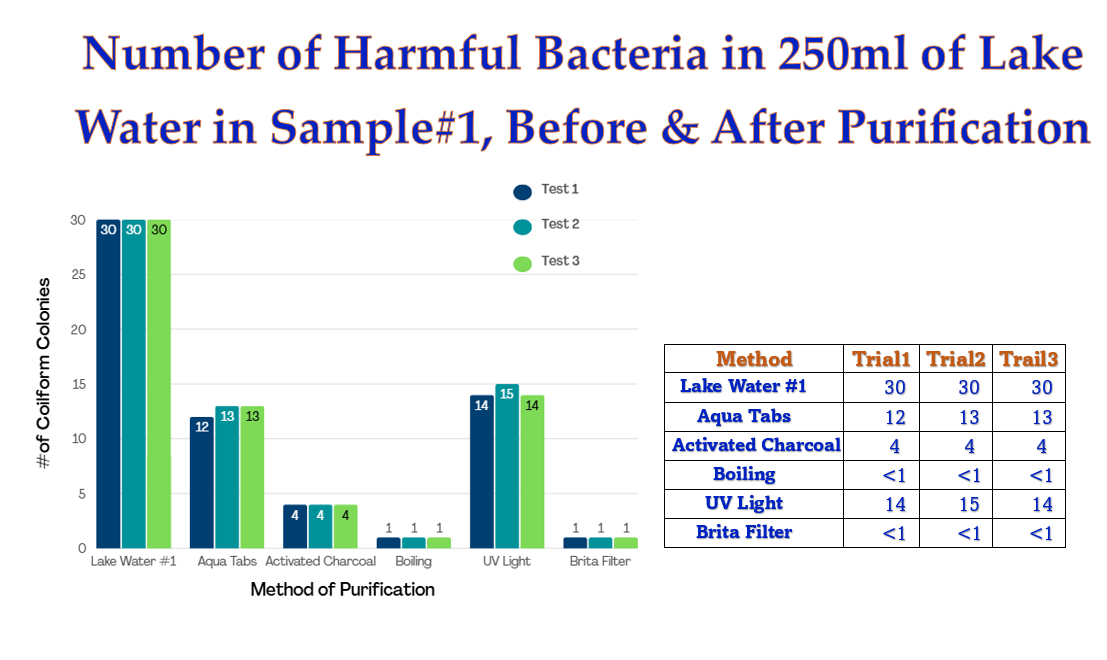
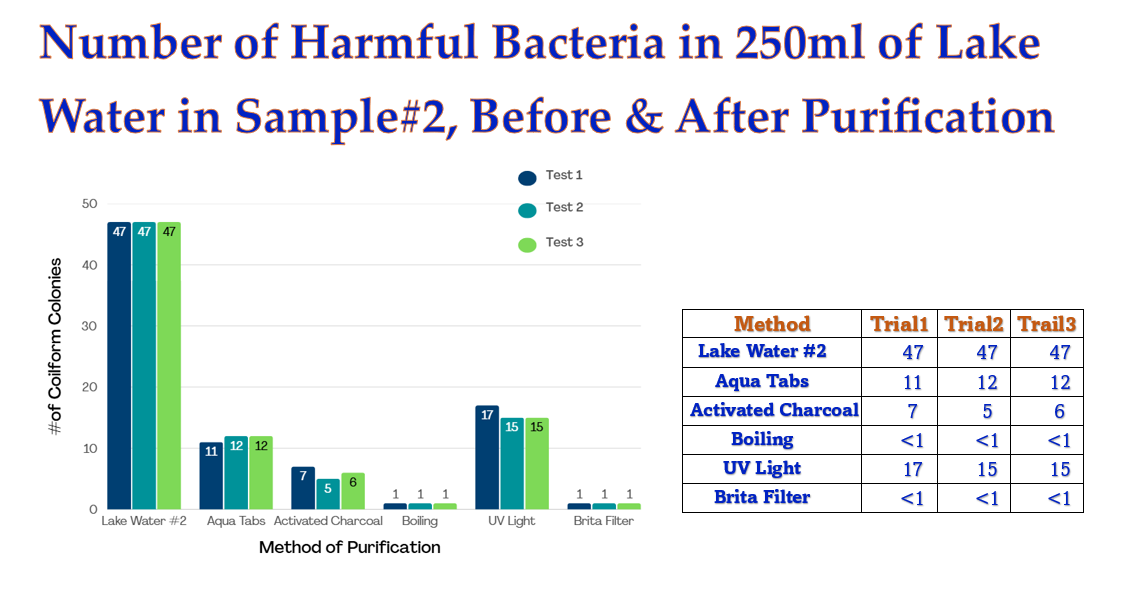

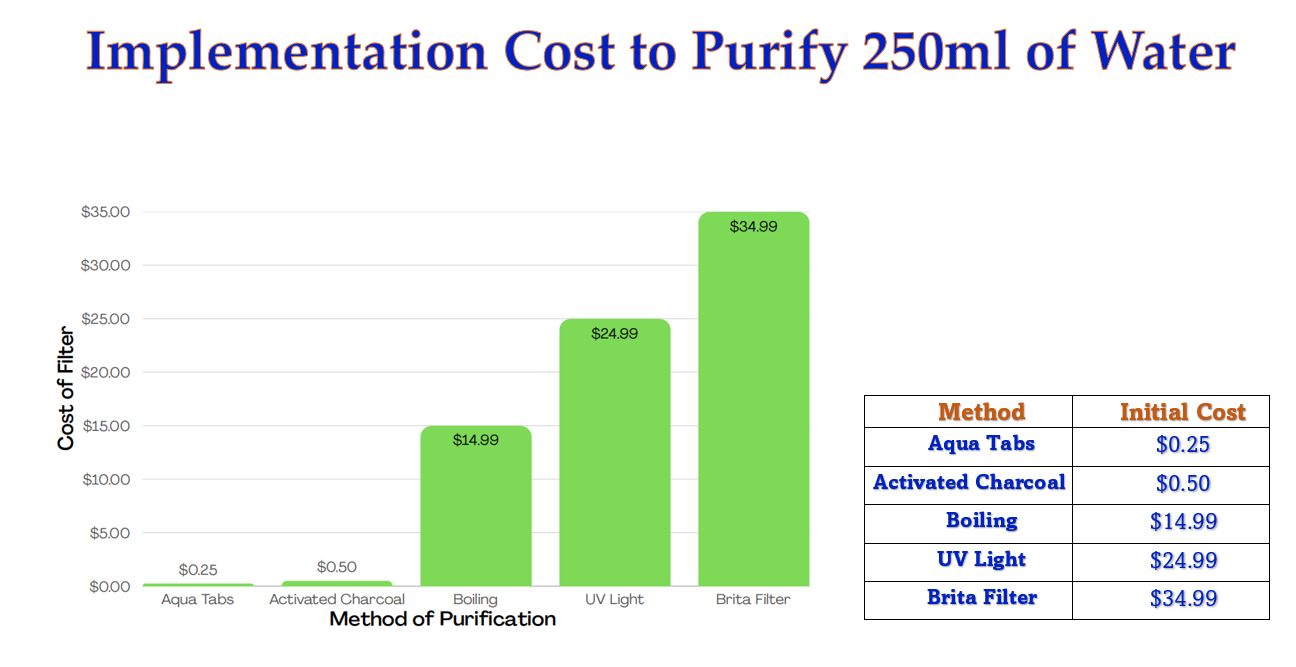
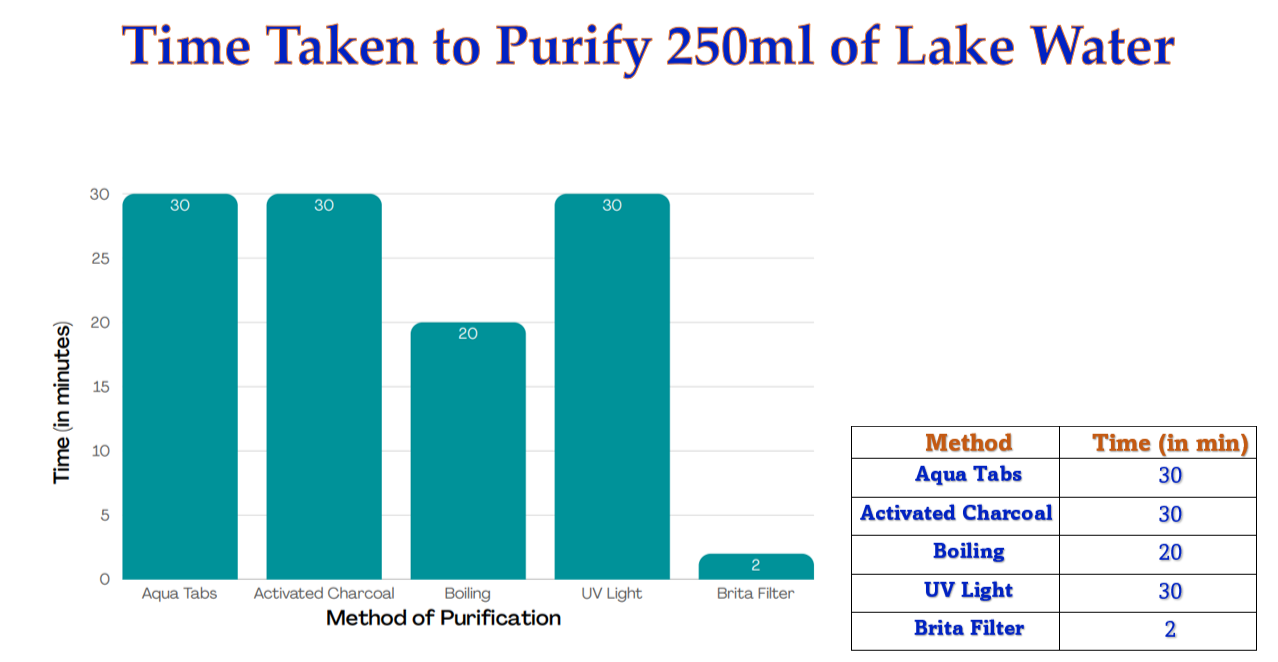
Analysis
Overview
Aqua Tabs Analysis:
- Moderately effective method in reducing coliform colonies
- Reduced bacteria with slight variability; colonies were 12, 13, and 13 across three samples for test Lake Water Sample #1
- Outlier, reduced to 12 colonies, slightly lower than 13 colonies in Tests 2 and 3 for test Lake Water Sample #1
- Reduced bacteria with slight variability; colonies were 11, 12, and 12 across three trials for Lake Water Sample #2
- Trial 1 (11) was an outlier for Lake Water Sample #2 and #3
- Reduced bacteria with slight variability; colonies were 11, 10, and 10 across three trials for Lake Water Sample #3
- Slow but low-maintenance method
- Took 30 minutes, the longest among the methods, but required minimal supervision, making it practical when time is less critical
- Cheapest per test, making it ideal for occasional or emergency purification
- Becomes less cost-effective for frequent use due to its per-use pricing
Activated Charcoal Analysis:
- Consistently reduced bacteria to 4 colonies across all samples in Lake Water Sample #1
- Reduced bacteria moderately; colonies were 7, 5, and 6 across three trials for Lake Water Sample #2
- Trial 2 (5) was an outlier for Lake Water Sample #2
- Reduced bacteria moderately; colonies were 5, 4, and 4 across three trials for Lake Water Sample #3
- Trial 1 (5) was an outlier for Lake Water Sample #3
- Uses mechanical filtration systems, employing mesh and absorption methods to remove contaminants
- Slow but low-maintenance purification method
- Took 30 minutes, the longest among all methods, but needed minimal supervision, making it practical when time is not critical
- One of the cheapest options per test, ideal for occasional or emergency filtration
Boiling Analysis:
- Highly effective purification method to remove the bacterial load in water
- Consistently reduced the coliform colony count to <1 across all samples
- Took 20 minutes but required supervision and a heat source, reducing its practicality in emergencies or resource-limited scenarios
- Most affordable and effective for frequent use, although it requires additional resources (heat source and equipment)
UV Light Analysis:
- Moderately effective method
- Reduced colonies with slight irregularity; colonies were 14, 15, and 14 across three samples for test Lake Water Sample #1
- Outlier, peak result of 15 colonies, an outlier compared to 14 colonies in Tests 1 and 3 for test Lake Water Sample #1
- Reduced bacteria with slight variability; colonies were 17, 15, and 15 across three trials for Lake Water Sample #2
- Trial 1 (17) was an outlier for Lake Water Sample #2
- Reduced bacteria with slight variability; colonies were 12, 13, and 13 across three trials for Lake Water Sample #3
- Trial 1 (12) was an outlier for Lake Water Sample #3
- Slow but low-maintenance purification method
- Took 30 minutes to filter water, the longest time among techniques, but required minimal supervision, making this method practical when time is less critical
- Higher upfront costs with added recurring expenses, offering convenience and consistent performance over time
Brita Water Filter Analysis:
- Highly effective filtration method
- Consistently reduced bacteria to <1 colony across all samples
- Fastest and most convenient method
- Took only 2 minutes per test, making it the fastest, most efficient, and most convenient option
- Higher upfront costs with added recurring expenses, offering long-term convenience and consistent performance over time
Graph Analysis
Lake Water Sample #1
The original sample, untreated lake water, consistently exhibits the highest number of coliform colonies, with 30 colonies across all samples. Among the tested methods, aqua tabs, activated charcoal, boiling, brita filter and UV light. The brita filter is our comparative method purification, since its known as the ideal water filter, developed using technologies that cannot be reproduced in emergency and household systems. Among the tested methods, boiling and the Brita Filter proved to be the most effective, consistently reducing bacteria levels to less than 1 colony in every sample. These methods showed complete reliability, making them the most effective for water purification. Activated Charcoal also performed well, consistently reducing bacteria to 4 colonies in all tests, though slightly less effective than boiling or the Brita Filter. Trends such as moderately effective methods included Aqua Tabs and UV Light, which demonstrated some variability in performance occurred. Aqua Tabs reduced coliform levels to 12-13 colonies, while UV Light lowered them to 14-15 colonies. These fluctuations could be influenced by factors such as inconsistent mixing, exposure time, or water quality. Notably, UV Light’s peak result of 15 colonies in Test 2 represents an outlier compared to its lower results in Tests 1 and 2 of 14 colonies. Meanwhile, Aqua Tabs also had a slight variation, with Test 1 showing 12 colonies compared to 13 in Tests 2 and 3 which is a potential outlier.
Lake Water Sample #2
The data from the three trials in the second lake highlights variations in the effectiveness of different water treatment methods, with some deviations indicating potential outliers. Untreated lake water remained consistent at 47 across all trials, confirming stable initial contamination levels. Aqua Tabs reduced contamination to 11, 12, and 12, showing effective disinfection, though the first trial (11) was a slight outlier compared to the other two. Activated charcoal showed moderate effectiveness with values of 7, 5, and 6, where Trial 2 (5) was an outlier, deviating downward from the trend. Boiling and the Brita filter were the most effective, consistently reducing contamination to 1 in all trials, showing complete removal of contaminants. UV light treatment achieved values of 17, 15, and 15, where Trial 1 (17) was an outlier, slightly higher than the others, possibly due to interference from particulates. While boiling remains the most reliable method for microbial safety, Aqua Tabs and UV light showed substantial reductions, with activated charcoal and Brita filtration further improving overall water quality. The minor deviations observed suggest variability in treatment effectiveness, potentially influenced by external factors such as water composition or exposure duration.
Lake Water Sample #3
For the third lake we tested, there were variations in the effectiveness of different water treatment methods in reducing contamination levels, with some minor deviations observed across trials. The untreated lake water maintained a constant value of 43 across all three trials, indicating stable contamination levels before treatment. Aqua Tabs significantly reduced contamination, lowering values to 11, 10, and 10 across the three trials. However, the result in Trial 1 (11) was a slight outlier, suggesting a minor inconsistency in disinfection efficiency, possibly due to slight variations in tablet dissolution or initial water conditions. Activated charcoal showed further improvement, bringing contamination levels down to 5, 4, and 4, with Trial 1 (5) standing out as an outlier, indicating a minor fluctuation in adsorption efficiency. Boiling proved to be one of the most effective methods, consistently reducing contamination to 1 in all three trials, demonstrating complete removal of contaminants. Similarly, the Brita filter also achieved consistent results, maintaining a contamination level of 1 across all trials, highlighting its strong filtration capabilities. UV light treatment reduced contamination to 12, 13, and 13, with Trial 1 (12) being a slight outlier compared to the other two trials. While UV light effectively neutralized microorganisms, the presence of residual contamination suggests potential limitations due to factors such as turbidity or particulate matter interfering with the treatment process. Overall, boiling and the Brita filter emerged as the most reliable treatment methods, achieving complete contamination removal across all trials. Aqua Tabs and UV light provided substantial reductions, though small variations indicate that their effectiveness may depend on factors such as exposure time and water composition. Activated charcoal showed moderate success but displayed minor inconsistencies. The small outliers observed in Aqua Tabs, activated charcoal, and UV treatment suggest that while these methods are effective, they may be influenced by subtle external factors, reinforcing the importance of using multiple treatment strategies to ensure optimal water quality.
Time Taken Analysis
The time taken analysis of water purification techniques shows that brita filter took the least time for only 2 minutes per test demonstrating its efficiency. While boiling took 20 minutes, 10 minutes for the pre-boil process to achieve a rolling boil, and 10 minutes for a constant boil. The rest of them all took 30 minutes to filter 250mL water. The aquatabs took long to react with the lake water. The time taken for activated charcoal was also 30 minutes because the carbon had to absorb most of the bacteria in the water. Finally, the time required for UV treatment was 30 minutes again. This shows us that boiling the most similar and comparable to the Brita filter. The need of supervision and a heat source, makes it less convenient in emergencies or when resources are limited. Whereas all other process may take longer but could be left alone without constant maintenance.
Cost Analysis
The cost analysis of water filtration methods reveals key differences in affordability and long-term value, based on purchasing the cheapest items with a rating of over 3.5 to ensure both quality and cost efficiency. Aqua Tabs, at $0.25 per use, are the most affordable option, followed by Activated Charcoal at $0.50 per use. These single-use methods are ideal for short-term or emergency purification but may become costly with frequent use. In contrast, the other methods represent a one-time cost. Boiling, with an initial cost of $17.94 is the most affordable long-term solution, especially for frequent water purification. UV Light, priced at $24.99, offers moderate upfront affordability but has variable bacterial reduction results compared to boiling. The Brita Filter, at $39.97, is the most expensive option with the need for repurchasing inner filters but combines effectiveness, consistent performance, and fast filtration time. However boiling takes up extra resources The data suggests a trade-off between upfront cost, effectiveness, and practicality. Aqua Tabs and Activated Charcoal are economical for occasional use, while boiling offers a low-cost, effective long-term solution.
Conclusion
The results demonstrated that boiling was the most effective method for reducing bacterial load, consistently lowering the number of coliform colonies to less than 1 per sample. This performance was identical to that of the Brita filter, which served as our comparative method for water purification. These findings confirmed the initial hypothesis, as boiling effectively eliminated bacterial pathogens by using high temperatures to damage their structural components, including proteins and cell membranes. This process ultimately halts essential life functions, preventing bacterial growth and ensuring safer drinking water. In contrast, other methods such as AquaTabs, UV light, and activated charcoal, while effective to varying degrees, showed minor inconsistencies across trials. These variations suggest that external factors such as water composition, exposure duration, and the presence of particulates may influence their effectiveness. Overall, the consistency of boiling as a treatment method, along with its ability to provide complete bacterial removal without dependence on chemical additives or filtration, makes it the most reliable approach for water purification in this experiment.
Application
- Examine a wider range of contaminants, including heavy metals, pesticides, and microplastics, and measure TDS and pH to assess chemical impacts.
- Evaluate scalability for real-world use, considering cost-effectiveness in high-usage households and emergency scenarios.
- Explore combined filtration systems like UV light with activated carbon to improve efficiency.
- Use larger sample sizes and more rigorous methods for more reliable results.
- Revisit distillation and reverse osmosis, which were limited by technology access, with a fully equipped lab to reduce cross-contamination.
- Study long-term performance and durability of filtration systems, using DNA sequencing to assess microbial communities.
- Integrate smart technology for real-time water quality monitoring.
- Explore biodegradable or renewable filter materials and assess accessibility in resource-scarce regions.
- Increasing sample size improves result accuracy and reliability.
Sources Of Error
Possible sources of error that may have influenced the results of the water filtration experiment include errors in counting coliform colonies could occur, and inaccuracy in the lab. Improper handling of water samples, such as cross-contamination between tests or uneven mixing of additives like Aqua Tabs, could also influence results, which may have led to the outliers found in AquaTabs and UV Light. The performance of filtration equipment, such as the Brita Filter or UV Light device, may degrade over time or vary depending on product quality. Inconsistent results could arise from filters being near the end of their lifespan or using low-powered UV light sources. Timing errors, such as slightly overestimating or underestimating the duration of boiling, UV light exposure, or Aqua Tabs dissolution, could also impact the consistency of bacterial removal.
The performance of reusable filters (e.g., Brita or Activated Charcoal) could degrade with repeated use, affecting results if the same filters were used across multiple tests without proper cleaning or maintenance. Additionally, the method of taking water samples after filtration may have introduced slight errors. For instance, residual bacteria in test containers or uneven sampling could skew results. Accounting for these sources of error is essential to refining experimental methods and improving the reliability of future tests.
Citations
https://pubmed.ncbi.nlm.nih.gov/23635477/ - Hines, L., & Green, D. (2013). The impact of water fluoridation on public health: A review of recent literature. American Journal of Public Health, 103(4), 634-640
https://www.healthline.com/nutrition/how-to-filter-water#diy-methods - Healthline. (2023, March 21). How to filter water: DIY methods & options. Healthline.
https://www.sciencedirect.com/science/article/pii/S2772397621000010#:~:text=The%20orange%20peels
%20biosorbent%20is,and%20nitrate%20removal%20from%20water - Saha, M., & Bandyopadhyay, M. (2021). The orange peels biosorbent is an effective material for arsenic and nitrate removal from water. Science Progress, 104(1), 1-12.
https://www.generationgenius.com/activities/water-quality-and-distribution-activity-for-kids/ - Generation Genius. (n.d.). Water quality and distribution activity for kids. Generation Genius
https://pubs.acs.org/cms/10.1021/acs.jafc.1c04199/asset/images/medium/jf1c04199_0005.gif - López, J. A., López-Miranda, J., Pérez-Jiménez, J., & Ordovás, J. M. (2021). The effects of extra virgin olive oil and its phenolic compounds on health. Journal of Agricultural and Food Chemistry, 69(19), 5407–5415.
https://ultraaqua.com/blog/uv-light-and-water-bacteria/ - Ultraaqua. (n.d.). UV light and water bacteria. Ultraaqua
https://www.ctc-n.org/technologies/solar-water-disinfection - Climate Technology Centre & Network (CTCN). (n.d.). Solar water disinfection. Climate Technology Centre & Network
https://www.medicalnewstoday.com/articles/322609 - Medical News Today. (2018, June 11). What is activated charcoal? Medical News Today
https://pmc.ncbi.nlm.nih.gov/articles/PMC4623834/ - Huang, J., Chen, G., & Wang, L. (2015). Applications of activated carbon in water treatment: A review. Frontiers in Environmental Science, 3, 1-13
https://share.upmc.com/2017/02/boiling-water-for-sanitation/ - UPMC. (2017, February 17). Boiling water for sanitation. UPMC.
https://www.waterdropfilter.com/blogs/water-contaminants/does-reverse-osmosis-remove-bacteria-and-viruses?srsltid=AfmBOorKi1zpo-QaJ61chSqa8SSTgDGY3lBya__qfYyXM1ZBQtGPjCG2 - Waterdrop. (n.d.). Does reverse osmosis remove bacteria and viruses? Waterdrop.
https://www.freshwatersystems.com/blogs/blog/what-is-reverse-osmosis?srsltid=AfmBOoq7ieaEam4rHbphhzmkDO5BuWB6w4oOeGj6psIAxxCy0Jq9IjUx - Fresh Water Systems. (n.d.). What is reverse osmosis? Fresh Water Systems.
https://www.freshwatersystems.com/blogs/blog/what-is-a-sediment-filter-and-how-does-it-work?srsltid=AfmBOorgP5IMCeMhz9DzqVOp53V9_fo96eExnwvEKON35OFptDRgnKIz - Fresh Water Systems. (n.d.). What is a sediment filter and how does it work? Fresh Water Systems.
https://ag.umass.edu/cafe/fact-sheets/distillation-treatment-of-drinking-water-supplies#:~:text=How%20Distillation%20Works,converts%20back%20to%20a%20liquid - University of Massachusetts Amherst. (n.d.). Distillation treatment of drinking water supplies. University of Massachusetts Amherst.
https://www.princeton.edu/~oa/manual/water.shtml - Princeton University. (n.d.). Water: A vital resource. Princeton University.
https://www.scientificamerican.com/article/how-does-chlorine-added-t/ - Scientific American. (2007, June 7). How does chlorine added to drinking water prevent illness? Scientific American
https://aquatabs.ca/pages/what-are-aquatabs#:~:text=When%20dissolved%20in%20water%2C%20Aquatabs,%2C%20Roto%20virus%2C%20Noto%20virus - Aquatabs. (n.d.). What are Aquatabs? Aquatabs https://dynamicheatandcool.ca/water-purifier-best-types-for-your-home/ - Dynamic Heat & Cool. (n.d.). Water purifier: Best types for your home. Dynamic Heat & Cool.
https://www.techgearlab.com/topics/kitchen/best-water-filter - TechGearLab. (2023, January 17). The best water filters of 2023.
https://www.nrdc.org/stories/water-pollution-everything-you-need-know - Natural Resources Defense Council (NRDC). (2022, September 1). Water pollution: Everything you need to know. Natural Resources Defense Council.
https://atlas-scientific.com/blog/effects-of-water-pollution/?srsltid=AfmBOoqQaRlKGD-_WcWm_dXEi9AFaYByz5nzFI37_YM3cXhPm4rWdT6Q - Atlas Scientific. (n.d.). Effects of water pollution. Atlas Scientific. https://www.epa.gov/report-environment/drinking-water#:~:text=If%20drinking%20water%20contains%20unsafe,chronic%20diseases%20such%20as%20cancer - U.S. Environmental Protection Agency (EPA). (2022, March 16). Drinking water. U.S. Environmental Protection Agency.
https://atlas-scientific.com/blog/effects-of-water-pollution/?srsltid=AfmBOoqQaRlKGD-_WcWm_dXEi9AFaYByz5nzFI37_YM3cXhPm4rWdT6Q - Atlas Scientific. (n.d.). Effects of water pollution. Atlas Scientific
Acknowledgement
I would like to thank Dr. Ashish from the University of Calgary and ALS Labs for their guidance and support throughout this project. I also appreciate my family for their continued support during this process.

